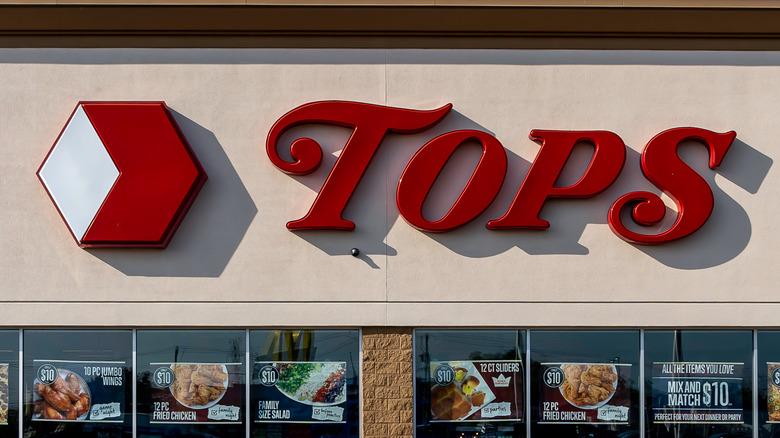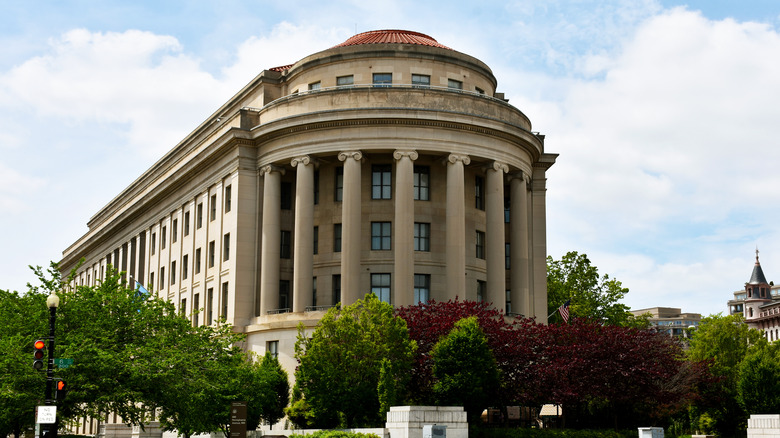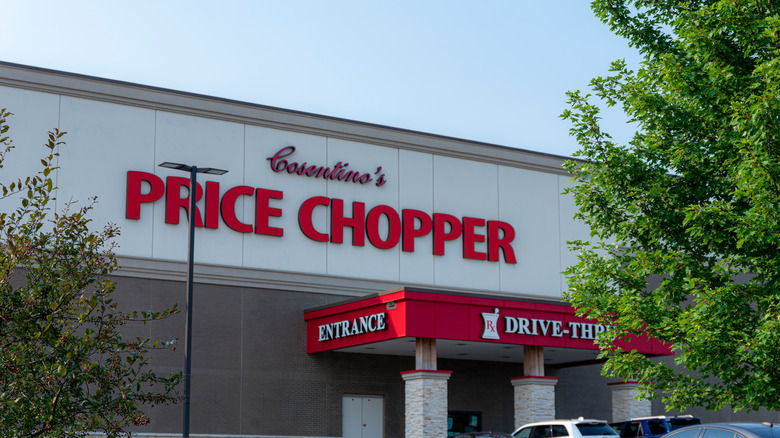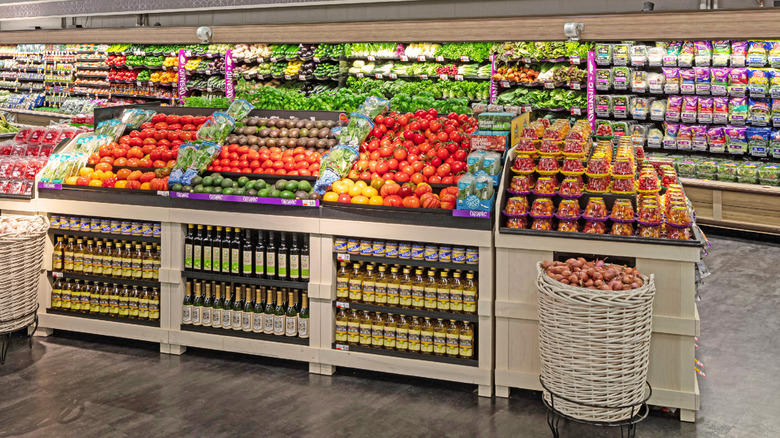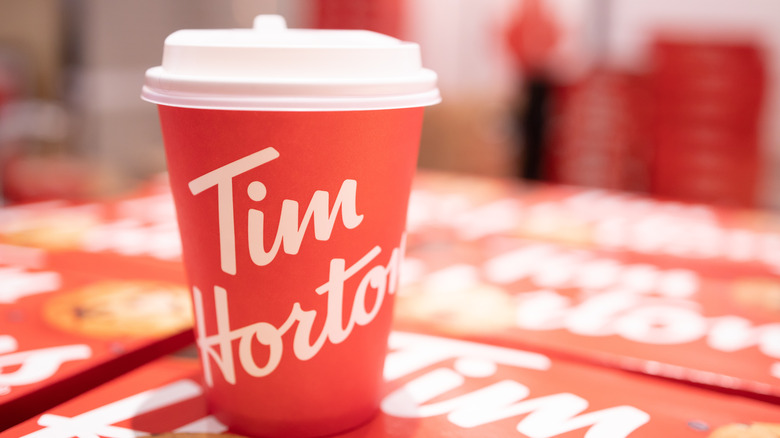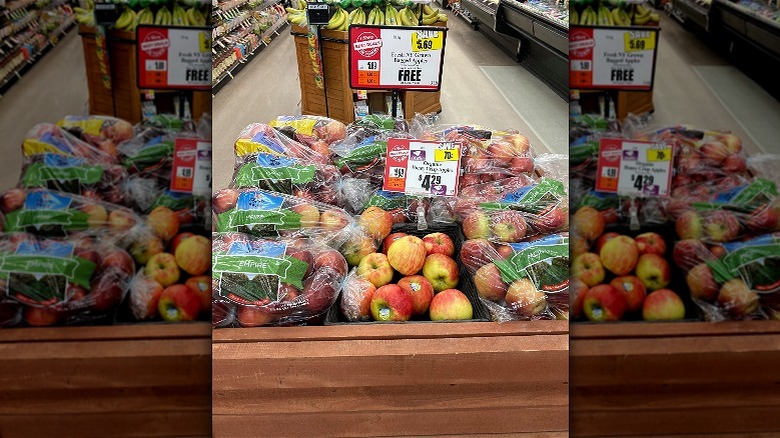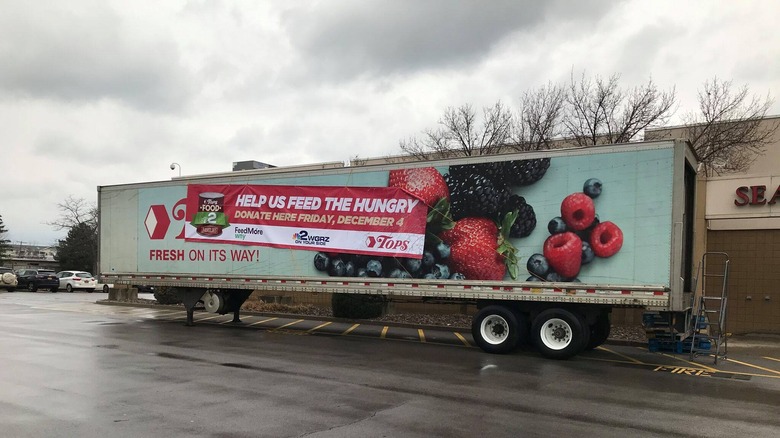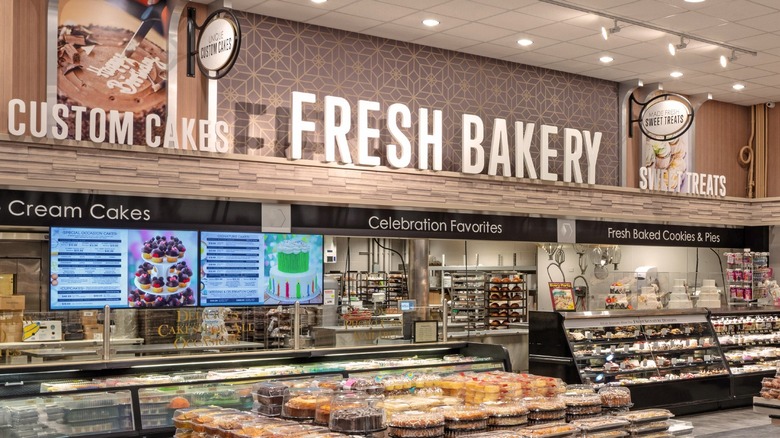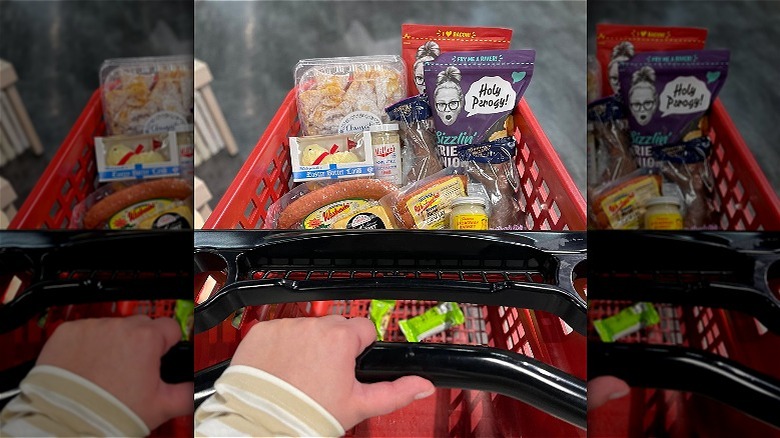The Untold Truth Of Tops Friendly Markets
For grocery shoppers up in the Northeast, Tops Friendly Markets remains one of the region's most dependable destinations. It's been in business for 60 years, and with over 150 locations in New York State, Pennsylvania, and Vermont, it's only become easier over the years to shop under its red and white roof. Simply put, there's a lot to love about this supermarket chain. A bountiful deli, fresh-off-the-farm produce, and exclusive items you won't find elsewhere are just some of the incentives for being a valued customer, and that's before we get to its delicious take-and-bake pizzas and doughnuts — made on-site, by the way (per Store Brands). Per Convenience Store News, it even has its own gas station.
Tops Friendly Markets has set a high bar for the full-scale supermarket and what it's capable of. After all, the name signals the superiority of shopping there. Yet it's also a pretty ordinary place, as anywhere you go to grab a quick dinner after work or replenish pantry staples is supposed to be.
However, you might not be familiar with the chain's background in the arena of grocery store history, and we've uncovered some facts that could surprise even the most dedicated of customers. For instance, do you know anything about the people behind the Tops brand? Or the supermarket's minor brush with bankruptcy? Whatever happened to that organic grocery store it launched? Without further ado, here's the untold truth of Tops Friendly Markets.
It's an institution in Upstate New York
From the very beginning, Tops Friendly Markets' roots have been firmly planted in Upstate New York. It's where the grocery store was established, as well as where the company operates to this day, with headquarters residing in the town of Williamsville and corporate staff working in the region (per Food Trade News). According to Tops Friendly Markets' website, founders Armand Castellani and Thomas Buscaglia opened the first location in Niagara Falls, following a decade-long partnership in developing the business model that would lead to its eventual debut in 1962.
It's no coincidence the city of Niagara Falls would mark the store's official launch into the supermarket stratosphere. For Castellani, Niagara Falls had been home since the 1920s when his family moved to America all the way from Rome, Italy. His father began a grocery store in town that would eventually unfurl into a family enterprise, with Castellani and his brother gaining experience in the business at a young age. Since then, the chain's spawned over 130 locations in Upstate New York alone, per Tops Friendly Markets' store locater, with the lion's share found in populous cities like Buffalo and Rochester, respectively. One could say the chain's never left home, and in a sense, they'd be correct.
The business has switched hands multiple times
While Tops Friendly Markets gained momentum in the following decades under the guidance of a tight-knit team, its background shows that the business wouldn't stay in the same hands for long. Per the chain's website, Dutch conglomerate Ahold obtained the supermarket brand in 1991, which paved the way for greater expansion across the Northeast, including its entry into Pennsylvania for the first time. Furthermore, the investment lead to corporate offices moving to Carlisle, Pennsylvania for a window of time, as the company's portfolio also included another supermarket juggernaut, Giant, where its headquarters were located (via The Buffalo News).
Of course, being bought out by a much larger company has its benefits, among them the financial security that's often denied smaller franchises out of practicality. However, it also meant a sharper detachment from the daily duties the chain prioritized at home in New York. Tops Friendly Markets existed here until 2007 when the New York-based firm Morgan Stanley Private Equity swooped in and bought the chain for $310 million.
As The Buffalo News reported, the deal would transfer jobs back to the state and allow for independence outside the conglomerate's umbrella. Eventually, an acquisition guided by CEO Frank Curci in 2013 restored company ownership to a local level, where it's remained ever since.
Tops has gone in and out of bankruptcy
What American business hasn't had a brush with bankruptcy? Debt can drag down the most prosperous of chains, and Tops Friendly Markets is certainly no exception to getting its financial ducks all in a row. In February 2018, the company declared Chapter 11 bankruptcy in order to pay off millions accrued during the period of ownership under Morgan Stanley Private Equity. On top of crushing debt, The Wall Street Journal noted issues with its union and the purchase of a logistics warehouse also added to the tab. Shouldering a massive debt burden and competitive market, as The Ithaca Voice wrote, would prevent Tops from meeting its long-term business goals.
Considering these circumstances, we'd imagine Tops Friendly Markets felt some pressure to meet the problem head-on — who wouldn't with that debt load? — but CEO Frank Curci confirmed the decision was made by choice. "We knew we were getting pushed in that direction and the level of debt that we accumulated under past ownership was no longer sustainable in today's competitive environment," he revealed to Food Trade News. "We were at the point where we could not do the things that we needed to do to sustain and grow our business." It paid off: In November of the same year, the Associated Press reported that it'd bounced back from bankruptcy, and lowered its debt by nearly $445 million.
Tops has gotten in trouble with the Federal Trade Commission
When Tops Friendly Markets purchased the now-defunct retailer Penn Traffic to expand its footprint via Syracuse.com, it probably didn't expect to land in hot water with a government agency. Back in 2010, the Federal Trade Commission halted the deal from going forward on the grounds that it violated antitrust laws. The FTC argued that seven of the 79 stores were located in areas lacking an abundance of competitors that could possibly pave the way for exploitative business practices (via Supermarket News). To put it another way, if Tops Friendly Markets was the single supermarket option for miles, it could easily benefit from the situation by raising prices, thus leaving customers no choice in the matter of where to do their shopping.
To amend the situation, Tops Friendly Markets had to find prospective buyers to take on the properties instead within 30 days. Despite the seemingly reasonable solution, not everyone found it to be satisfactory. Union president Frank DeRiso defended the grocery store, saying it was "not a threat" to customers. As he told Supermarket News at the time, "In fact, Tops falls into the guidelines of protecting the consumer, and the fact is that prices have gone down as a result of Tops purchasing Penn Traffic stores." Even factoring that in, the agency still has a responsibility to weed out any potential issues that could impact transparency, no matter how minuscule on the surface.
It joined forces with another grocery giant
From Kraft and Keinz to McCormick and Cholula, corporate mergers in the food world seem to happen left and right these days (via Food Dive). Tops Friendly Markets joined this list in 2021, when it announced a formal partnership with another New York-centric grocery chain, Price Chopper/Market 32. According to an official press release outlining the deal, a parent company forged by the two chains would oversee maintenance of both Tops and Price Chopper/Market 32 stores, effectively expanding its scope across the region.
It's safe to assume that competition is fierce for a grocery store like Tops Friendly Market. So why would it decide to merge with a potential rival? It turns out joining forces poses plenty of upsides that help, rather than hinder, its business. Both claim a similar stronghold in the Northeast, particularly in New York where each of its main offices resides in Williamsville and Schenectady, respectively (via Progressive Grocer). Both have also been in business for at least a century, and the fact that each is still standing goes to show the kind of longevity the brands possess. If it's likely that customers will grab their groceries at one or the other, then forging a coalition ensures each chain mutually benefits from it. As the saying goes, two heads are better than one!
Much of the inventory is locally-sourced
Shopping for hand-picked apples or fresh eggs feels like a pipe dream at your average grocery store, but not at Tops Friendly Markets. The chain makes it a delicious reality, maintaining a fleet of 200+ farms, orchards, and small businesses to stock the shelves of stores every day (via Tops Friendly Markets). All of the businesses are local to New York and Pennsylvania, which include fruits and vegetables from Harrington's Produce in Elba, Donovan Orchards in Rochester, and Klenz Farms from Erie, Pennsylvania.
There's no doubt locally-sourced goods benefit the businesses who supply them, but it's also a boon for shoppers seeking the highest quality items. As Senior Vice President Diane Colgan revealed to Store Brands in 2019, items reach the stores very quickly as a result of the close proximity. "The product is literally coming out of the fields and going into the stores in many instances within 48 hours," Colgan said. One impressive example comes from the eggs, which are collected from a farm neighboring its headquarters and are often delivered to the store the same day they were laid. Tops Friendly Markets provides a true farm-to-table experience with the inventory that rolls through its stores, and this makes them stand out in a sea of competitors.
Tops carries Tim Hortons and Anchor Bar
We know that Tops Friendly Markets stocks smaller brands, but were you aware of some of the bigger names found on its shelves? Per NPR, 2008 was the year the grocery chain started selling coffee and doughnuts from Toronto-based chain Tim Hortons inside stores in either a full-scale or quick-stop format. That same year, chicken wings from Buffalo's Anchor Bar got a prime spot in the store's carryout section, which sells ready-to-eat foods (via Progressive Grocer). In case you're not familiar with Anchor Bar, it's credited with creating the tailgate snack consumed in the billions every Super Bowl Sunday, according to the National Chicken Council.
Partnering with both brands, on Tops Friendly Markets' part, was an effective strategy. Not only is it convenient for customers wanting to do all their shopping in one place, but its accessibility allows for trying wares one otherwise would have to drive long distances for. In the case of Anchor Bar, its wings weren't available outside the restaurant until signing the deal with Tops via Progressive Grocer, so you'd have to venture out to Buffalo to get a taste of the legendary wings for yourself. Hosting them under the banner of Tops Friendly Markets reinforces the brand's identity.
It once opened an organic grocery store
With the rise of gourmet grocery stores like Whole Foods, it isn't surprising other chains responded to its frenzy by hopping on the bandwagon. Tops Friendly Markets embraced the all-natural trend in 2013 when it launched a new concept called Orchard Fresh (via Buffalo Business First). Aptly located in Orchard Park, New York, the store aimed to attract customers craving fresh, organic foods, which is a reasonable pivot for a supermarket to make. However, it failed to take off the way the chain hoped, and in 2020, Orchard Fresh officially shuttered for good (via Grocery Dive).
It's puzzling how an idea like Orchard Fresh could tank, but Grocery Dive shed some insight on how it happened. The big one was bankruptcy, which interfered with the chain's plans to develop the concept further than the lone storefront. The store was also in an isolated area, so residents found it inconvenient to shop there. As a result of this oversight, many people didn't even know about the store at all (ouch). In the end, Tops Friendly Markets decided to scrap the project altogether and focus its financial energy on improving the locations already in business. The ordeal produced a few bright sides, thankfully — organic fare made its way into regular Tops stores, while employees were offered new positions at other locations.
Tops has an app for cutting food waste
Food waste is an enormous problem in America. Besides making up at least 30% of the nation's total supply via the USDA, it also consists of perfectly edible food that could be on someone's plate instead of decaying in a landfill. Tops Friendly Markets recognizes this, because it hosts an app to do its part and help customers save money, too. Flash Food marks down items reaching their sell-by date (think at least 50%), which customers can purchase online and arrange for in-store pick-up. Plus, the app offers nifty perks to make the whole experience satisfying, like tracking the emissions cut and dollars saved just by using it (via Flash Food).
Snagging ground beef or milk at ridiculously low prices is surely the main driver of why customers flock to the Flash Food. And judging by the positive reviews, it gets people experimenting in the kitchen with ingredients outside their wheelhouse. Most of all, it's proven successful in preventing food waste. While not every Tops utilizes the app, its results are far from meager: due to its widespread use, 38 million pounds of food from the chain have been diverted from the trash and into shopping carts instead. Not bad for your neighborhood grocery store!
Tops Friendly Markets is committed to helping others
It's true that Tops Friendly Markets sustains its shoppers with nourishing fare, but it also feeds the community in ways that go beyond its literal definition. The grocery chain is active in the community, and a look at its website will showcase the charitable causes it's supported over the years. The grocery chain has raised money for food banks, children's hospitals, schools, military groups, and many more (via Tops Friendly Markets). Some stores even act as safe harbors for children requiring professional assistance, such as mental health counseling.
Of course, the retailer has donated directly to these organizations, whether it's through fundraisers or giving away meals to those in need. But much like the commitment to fighting food waste, the chain also has ways of encouraging customer participation, too. There's the Tops in Education program, which lets shoppers support local schools by donating a percentage of any purchase made in-store. The Feeding Families initiative, meanwhile, takes place during the holidays for customers to donate spare change or buy a bag filled with food for $5, $10, and $20 that goes towards food banks across the region, per Niagara Frontier Publications.
It has invested in the shopping experience
The power of an aesthetically-pleasing supermarket cannot be understated. Whether it's clean aisles or bountiful counters of food, an attractive layout turns a mundane activity like grocery shopping into an enjoyable experience. In recent years, the folks at Tops Friendly Markets have rolled out some noticeable improvements following its relief from bankruptcy in 2018. Renovations, which amount to the tune of $40 million, have covered upgraded interiors, an expanded deli section, and stations for on-site produce prep at all its locations (via Store Brands).
Where big-box supermarkets offer low prices to draw foot traffic, Tops Friendly Markets prioritizes experience-oriented perks usually not found at the typical grocery store. As a matter of fact, distinguishing itself from the crowd proved necessary to compete in the first place. In an interview with Food Trade News, CEO Frank Curci commented on the "impossible" prospect of meeting stores like Walmart head-on. "We do have a strong own brand offering, we do have a promotional format, but trying to match Walmart on price is very difficult for a company like us," Curci said. "We have to do other things to attract people and those other things have to be around experience and solutions." Investing in the shopping experience seems to be the solution, and a solution that's worked.
Tops is okay with being a smaller company
Don't get us wrong — Tops Friendly Market remains firmly entrenched as a supermarket institution showing no signs of slowing down. But at under 200 stores with 14,000 employees via Food Trade News, the chances of the brand dominating the globe seem remarkably slim. And honestly, Tops is okay with that. Being a smaller company has helped it persevere in a region that CEO Frank Curci has described as "no-growth" for the supermarket business. "I like our size," Curci relayed to Food Trade News. "I like that we are small enough that we can understand our stores but still big enough to have some scale." There are also the perks of working in Upstate New York compared to other regions of the U.S., which has paved the way for the supermarket's long-term success.
Part of the grocery store's appeal is its home-grown connection to the community, and it's this same community, that's fostered the growth to make it into the sizable chain it is today. Referring to his home base of Buffalo, Curci noted the impact of staying close to home: "Here you can build a business and sustain it for the long run" which in turn, transforms into trust among the shoppers frequenting Tops Friendly Markets for their daily needs.
